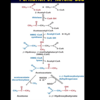Fatty acid synthesis and degradation Flashcards
80% of Energy needs of mammalian heart and liver Are provided by
Fatty acids
fatty acids
What is beta oxidation
Repetitive four step process by which FA’s are converted into acetyl CoA
fatty acids
How is energy made from Beta Oxidation
- Electrons removed from FA pass through ETC making ATP
- Acetyl CoA produced from FA may be completely oxidizes to CO2 in TCA cycle
- Acetyl CoA may also be converted to ketone bodies in liver and exported to the brain and other tissues when glucose is limiting
fatty acids
Advantages of triacylglycerol’s as storage fuels
- Highly reduced structures: two times the energy for the same way compared to carbohydrates or protein
- Triacylglycerol’s aggregate in the lipid droplets and so do not raise osmolality of cytosol
- They are inert chemically
fatty acids
What are the sources of fat
Dietary, lipid droplets in adipose tissue (triglycerides), fats synthesized from excess carbohydrates in liver
fatty acids
Provides more than half of energy to liver, heart and resting muscle and is virtually the sole source of energy and hibernating animals in migrating birds
Triglycerides
fatty acids
What are micelles
- aggregate of surfactant molecules dispersed in a liquid colloid.
- A typical micelle in aqueous solution forms an aggregate with the hydrophilic “head” regions in contact with surrounding solvent, sequestering the hydrophobic single-tail regions in the micelle centre.
fatty acids
What degrades triacylglycerol in diet
Intestinal lipases
fatty acids
How are chylomicrons made
Triacylglycerol’s are incorporated with cholesterol and a polypoproteins
Phopholipid surround them
fatty acids
What are the fates of fatty acids in diet
Maybe oxidized as fuel Or Reesterfied for storage
fatty acids
What does lipoprotein lipase do
Converts triacylglycerol to fatty acids and glycerol
fatty acids
What activates lipoprotein lipase
ApoC-II in Capillary
fatty acids
Acts as signal in uptake and metabolism of fatty acids
Apolypoprotein
fatty acids
Describe the composition of chylomicrons
80% is made up of triacylglycerol’s which are in the interior, there is also dietary cholesterol, and specific proteins such as apolipoprotein
fatty acids
Glucagon causes what
- Hormone binds receptor in adipocyte membrane
- Stimulates adenylil cyclase via G protein producing cyclic AMP
- PKA is activated, phosphorylates lipase and Perilipin on surface of lipid droplet
- lipase hydrolyzes triacylglycerols to free fatty acids
- fatty acids leave adipocyte, Bind serum albumin in blood , carried in blood; released
- Enter myocyte via fatty acid transporter; Can then be oxidized to CO2
fatty acids
What percentage of energy from triacylglycerol’s resides in their fatty acid chains
90%
fatty acids
Glycerol moiety contributes what percentage of energy from triacylglycerol
5%
fatty acids
What happens to glycerol after it’s released by lipase
- It is phosphorylated by glycerol kinase
- Glycerol three phosphate is oxidized to DHAP - via Glycerol 3 phosphate dehydrogenase
- DHA P is converted to glyceraldehyde 3 phosphate via Triose phosphate isomerase
- it is then oxidized via glycolysis
fatty acids
What happens when fatty acids enter myocytes
They are activated and transported into mitochondria
- Catalyzed by fatty acyl CoA synthetases and inorganic PPI 2.
Two steps –
- Carboxylate ion displaces outer to phosphates of ATP to form a fatty acid adenylate; PPI is immediately hydrolyzed pulling the reaction forward
- Thiol group of CoA carries out nucleophilic attack on enzyme
- bound mixed anhydride displaces AMP and forms thioester thioester – CoA -Highly exergonic

fatty acids
What is the carnitine shuttle
- Rate limiting step of beta oxidation
- Most fatty acids with a chain length of 14 more can pass directly through the mitochondrial membrane
- Convert to fatty acyl– CoA and React with carnitine to form fatty acyl–carnitine
Enzyme: carnitine Acyltranferase I
- pass through mitochondrial Outer membrane via pores and enters matrix via acyl– carnitine/carnitine transporter of inner mitochondrial membrane
- Fatty acyl group is then transferred from carnitine to CoA in mitochondrial matrix
Enzyme: Carnitine Acyltranferase II
-Carnitine exist to cytosol to repeat cycle
fatty acids
What are the three stages of fatty acid oxidation
- Fatty acid undergoes oxidative removal of successive to carbon units in form of acetyl CoA (beta – oxidation)
- Acetyl groups are oxidized to CO2 via TCA cycle
- Electrons from oxidations of stage one and 2 pass to electron transport chain making ATP by Oxidative phosphorylation
fatty acids
What are the four basic steps of beta oxidation of saturated fatty acids
- Dehydrogenation of fatty acyl CoA produces a double bond between C2 and C3, yielding trans – enoyl CoA
FAD is electron acceptor; electron from reaction enters electron transfer chain -
Enzyme: aCYL – CoA Dehydrogenase
- Hydration to form beta hydroxy acyl- CoA -
Enzyme: Enoyl – CoA hydratase
- Dehydrogenation to form beta ketoacyl – CoA; NAD plus is electron acceptor; NADH formed donates its electron to NADH dehydrogenase of respiratory chain; ATP formed as an electron Passed to O2
- Enzyme: beta hydroxyacyl- CoA Dehydrogenase - Thiolysis : cleave carboxy – terminal 2 – C fragment of fatty acid as acetyl – CoA and CoA Thioester from original fatty acid.
- Enzyme:acyl CoA Acetyltransferase (thiolase)
fatty acids
What are the products of palmitate oxidation
- 8 acetyl CoA
10 ATP per acetyl CoA = 80 ATP
- 7 FADH2 = 1.5 ATP
- 7 NADH = 2.5 ATP
- 7 H+
- 4 ATP formed per beta oxidation (1 NADH and 1 FADH2)
- 7*4 ATP/pass = 28 ATP
- Total= 28+ 80 = 108 ATP
fatty acids
Regulation of beta oxidation
- Carnitine shuttle is rate limiting step
- malonyl-CoA- first intermediate from FA synthesis inhibits carnotine acyl transferase
- High [NADH/NAD+] ratios: inhibit beta- hydroxyacyl dehydrogenase
- high Acetyl CoA: conc. inhibits thiolase












